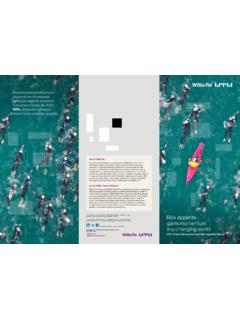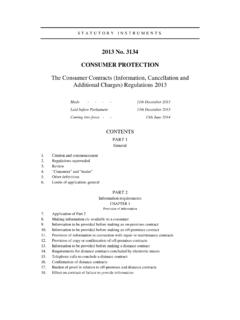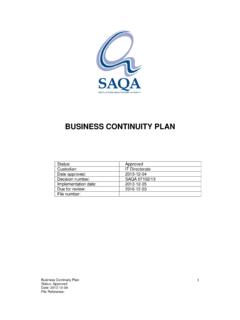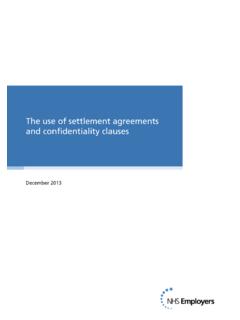Transcription of HOW TO HANDLE ORSA - Welcome To Willis Re
1 DECEMBER 2011/JANUARY 2012 VOLUME 8 ISSUE 6 THE SOA S COMPETENCY FRAMEWORKHere s how to put it to work for ACTUARIAL PROFESSION IN INDIAIt is now dynamic and lucrative. HOW TO HANDLE ORSAAre you ready for the changes?Self Assessment. In Australia, it takes the same name as a similar process for banks, the In-ternal Capital Adequacy Assessment Process or ICAAP. Other regulators in other countries are expecting to join in. The Insurance Core Principles are a part of the enhanced regu-latory thrust of the global Financial Stability Board under the authority of the G20 heads of state.
2 The Financial Stability Board will be expecting a status report on implementation late in IS ORSA NEEDED?In the past, solvency standards were always retrospective. They focused on past balance sheets to determine if an insurer had enough capital at the end of the last year for the risks that they held then. But what regulators re-ally need to know is if an insurer has enough capital for the risks solvency standards also focused on capi-tal determination based on the regulator s es-timate of the firm s risk. But the more impor-tant question is if there is enough capital for the risks as they really mentioned above, existing solvency stan-dards make the regulator responsible for certifying solvency.
3 The standards imply that if an insurer passes, then the insurer has enough capital. But large banks that had passed the Basel II solvency standards suc-cumbed to the economic crisis. Regulators have therefore decided to make the manage-ment and board responsible for certifying solvency, in hopes that they will do a better job of reflecting the actual risk position and capital needs of the TO THE NAIC S ORSA PROPOSALThe NAIC has exposed two different versions of an ORSA requirements for comments in late 2010 and in the spring of 2011.
4 Reactions to the ORSA are mixed: We agree that introduction of an ORSA requirement into the solvency framework could provide regulators with meaningful insights into a company s risk management practices. American Academy of Actuaries ACLI believes that consideration of the scope and effectiveness of an insurer s risk management framework should be an integral part of the supervisor s assess-ment of an insurer s solvency. Our mem-bers believe that an insurer must have a sound process for assessing its capital ad-equacy in relation to its risk profile.
5 That process must be integrated into its man-agement processes and decision making culture, and the culture must in turn em-brace an active internal risk assessment and risk management processes. Our members would therefore support a re-quirement that an insurer regularly assess its reasonably foreseeable material risks to ensure that its total financial resources are adequate to meet its insurance obli-gations at all times. American Coun-cil of Life InsurersWITH REGULATORY CHANGES FOR INSURERS LOOMING ON THE HORIZON, THIS ARTICLE GIVES READERS AN IDEA OF WHAT TO EXPECT SO THEY CAN COME UP WITH A WINNING GAME PLAN.
6 BY DAVE INGRAM24 | THE ACTUARY | DECEMBER 2011/JANUARY 2012 SEVERAL YEARS into the Risk Based Examination process, the National As-sociation of Insurance Commissioners (NAIC) now is working to augment that pro-cess with a significant new risk related regula-tory requirement for insurers. This new process, the so-called ORSA, or Own Risk and Solvency Assessment, moves insurance solvency regulation into new territory. Insurer and reinsurer management who will now be called to articulate their own judgment about the adequacy of their firm s capital may see this is an abrupt shift from the longstanding practice of regulators specifying the exact requirements for assessing insurer solvency.
7 The new judgment from management is ex-pected to better reflect the risks , risk manage-ment capacity and capital as well as the fu-ture plans of each insurer. Many of the largest insurers may have developed the capabilities and have been applying those capabilities for at least half a decade now, but mid-sized in-surers may need to get to change comes from an agreement of the international insurance regulatory com-munity for a set of Insurance Core Principles (ICPs) in October, 2010. The new require-ment for solvency is recorded in ICP 16, titled Enterprise Risk Management.
8 ICP 16 calls for an ORSA which is already embed-ded in Pillar 2 of Solvency II. In the United States, ORSA is currently under discussion for adoption by the NAIC later in 2011 or ear-ly 2012. Implementation by the states would follow in 2013 and after. In Bermuda it will be called the Commercial Insurers Solvency The ORSA process should not mandate specific approaches but should focus on verifying that insurers are thinking about and managing their risk exposures. Aegon We urge the NAIC to be sensitive to the extraordinary effort that will likely be re-quired of all carriers to complete a risk assessment appropriate to the compa-ny s risk profile.
9 America s Health Insurance Plans We believe that the current solvency system is functioning well.. During the recent period of major financial failures, the lack of insurer insolvencies has been a source of pride for the NAIC. This out-come suggests that the current solvency regulatory system is ample, if not robust. While there may always be room for im-provement, it would be a stretch to sug-gest that the current system is broken and should be revamped. This proposal seems to increase the overall regulatory require-ments without deriving tangible benefits.
10 Blue Cross Blue Shield Association The criteria included in the ORSA pro-posal (particularly Section 1) would best fit, after appropriate changes, as examination guidance of common cri-teria generally found in ERM programs. It would provide a basis for examiner evaluation without setting out de-facto requirements for ERM programs. Such requirements would seem to cross the line between regulator and manage-ment. As ERM practices further evolve, it would be easier to change examination guidance rather than a model law or reg-ulation.











